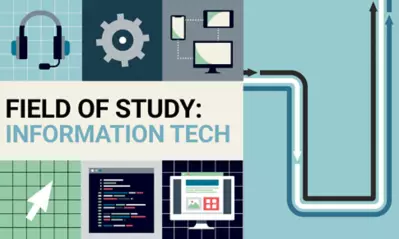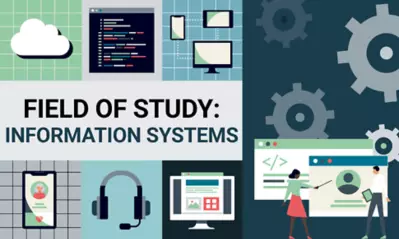Articles > Information Technology > Tech terms every IT professional should know
Tech terms every IT professional should know
This article was updated on Decemebr 30, 2024.

Written by Michael Feder

Reviewed by Kathryn Uhles, MIS, MSP, Dean, College of Business and IT

Information technology (IT) forms a crucial aspect of business processes across a number of major industries--from healthcare to e-commerce. If a role in IT interests you, there are a number of reccuring tech terms you need to become familiar with.
IT words and phrases every tech professional should know
Understanding the lingo is an important first step for anyone looking to enter into this field. To test or expand your knowledge of common IT terms, we’ve compiled the following roundup of the industry’s most-need-to-know terminology. And, if you’re having trouble remembering the difference between machine learning and artificial intelligence, our memorization tips have you covered.
1. Adaptive technology
This refers to modifying existing tech to make it more accessible for those with challenges or disabilities. This might mean using large monitors for easier reading or adjustable desks for people who rely on wheelchairs.
Why should I know this?
Adaptive technology helps ensure people with disabilities can work productively, which creates a more inclusive tech experience.
2. Augmented reality (AR)
Augmented reality allows users to project digital overlays onto real-life sights and sounds.
Why should I know this?
Because of augmented reality’s robust applications, many companies see potential in leveraging it.
3. Artificial intelligence (AI)
Currently one of the most popular tech terms out there, AI refers to machines using information to teach themselves various problem-solving tasks for an ever-changing environment.
Why should I know this?
AI can improve productivity, reduce costs and minimize human error, making it attractive to a range of industries and organizations.
4. Agile development
A software development philosophy that promotes a streamlined production and implementation pipeline for new software.
Why should I know this?
Agile development ensures that IT teams working across large networks are able to work in tandem and without disruption to endpoint users.
5. Big data
User data gleaned from various sources, such as website traffic and social media content.
Why should I know this?
When it comes to IT tech terms, “big data” is one you’ll hear a lot. Insights from big data analysis can give an organization crucial information about the future of its business.
6. Biometrics
Biometrics are physical characteristics that are unique to individuals and that can be collected as part of data sets.
Why should I know this?
Biometrics have the potential to make many services easier to use, but IT supervision is required to ensure this sensitive data is protected from bad outside actors.
7. Business intelligence (BI)
Business intelligence uses internal, historical business data to make informed decisions. BI is often presented to executives in reports with visual formats that delineate particular risks and opportunities.
Why should I know this?
BI can provide companies with a competitive market advantage, which means experienced IT analysts can have a direct impact on a company’s success or failure.
8. Bring your own device (BYOD)
This business philosophy means employees perform their work from personal devices as opposed to company-provided ones.
Why should I know this?
Whether employees are using their own devices or company-issued ones, IT engineers must ensure that security and efficiency are not compromised.
9. Cache
Many computational processes require data to be stored where it can be frequently accessed. The cache is where this kind of data is stored.
Why should I know this?
By taking advantage of cached data, computational processes can be performed faster and more efficiently.
10. Cloud
The cloud is any network of servers that are connected to perform a specific function by working together.
Why should I know this?
Being able to take advantage of cloud-based technology can translate to more efficient and cost-effective business processes. This is one of the most commonly heard tech terms today.
11. Cookie
A small packet of information that is saved on a user’s computer after visiting a website.
Why should I know this?
This is one of the more common computer science words out there. If you’re an IT technician in charge of managing a company website, then implementing cookies is a crucial step in providing users with a fast experience.
12. Content management
An umbrella term for the creation, storage and delivery of content such as video, images, text and audio.
Why should I know this?
In any given business, being able to seamlessly create, store and deploy new content is critical. Maintaining and backing up the server space necessary to manage this content is a common responsibility of an IT engineer.
13. Cross-platform
This term refers to software that works across multiple operating systems, programming languages and physical devices.
Why should I know this?
Efficient cross-platform business processes mean that everyone from employees to end users can access the same software, regardless of which platform they use.
14. Crowdsourcing
Using non-employees such as freelancers or volunteers to complete a given project.
Why should I know this?
In IT, there may be a task that cannot be completed using only internal company resources. Crowdsourcing can help fill that gap in a timely fashion.
15. Customer relationship management (CRM)
The total process of interacting with potential customers, moving them through the sales pipeline and analyzing the resulting data.
Why should I know this?
For many businesses, managing potential leads is essential to their bottom lines. These companies depend on IT engineers to ensure that CRM software is running smoothly.
16. Data analytics
Quite common among tech terms, data analytics is the process by which raw data is translated into pertinent and useful conclusions.
Why should I know this?
Knowledge is key, especially in competitive markets. The more you know how to translate raw data into usable information, the greater impact you can have at your organization.
17. Data center
The physical collection of servers that store and process a company’s data.
Why should I know this?
The upkeep of data centers, including software updates and hardware upgrades, falls under the responsibilities of the IT department.
18. Data security
The protection of data from unauthorized access, alteration or corruption.
Why should I know this?
Security is a high priority for any company working with data, as a breach can diminish customer trust. A background in cybersecurity offers real-life benefits in today’s market.
19. Disaster recovery/disaster recovery as a service (DRaaS)
The tools and practices that ensure the safety of the technology most critical to business functions. This includes being able to recover data in the event of a disaster.
Why should I know this?
Disasters happen, but implementing DRaaS practices can mean the difference between a minor and a major business disruption.
20. DevSecOps
The combined practices of development, security and operations. This is a design philosophy for IT systems that incorporates security precautions into the deployment and upkeep of new patches, updates and software.
Why should I know this?
DevSecOps is a crucial part of most modern IT infrastructures. It allows developers to create and deploy software quickly and in accordance with security protocols.
21. Disruptive technology
Any technology that presents a groundbreaking change in how a particular industry or several industries operate.
Why should I know this?
Keeping apprised of the latest and greatest technologies means you can implement the right ones more effectively.
22. Enterprise architecture
The analysis of how a business is structured, where bottlenecks occur, and where there are areas for improvement.
Why should I know this?
Understanding how a business operates can help you better manage your IT team and accomplish tasks in a timely manner.
23. General data protection regulation (GDPR)
Implemented in 2018 by the European Union (EU), this set of laws established the data protection and privacy guidelines for anyone handling data that stays within or passes through the EU.
Why should I know this?
Along with other aspects of regulatory compliance, keeping your data infrastructure in line with legal frameworks such as the GDPR is a prerequisite for many businesses working with personal data.
24. Graphical user interface (GUI)
The visual representation of computer processes that allows users to accomplish tasks without the need for command line code.
Why should I know this?
One of the useful tech terms for IT work related to user experience (UX), GUI allows for a more accessible user experience that can help customers or other employees use a given software with ease.
25. Green technology
Technological products and innovations that focus on reversing or mitigating ecological damage.
Why should I know this?
Green technology is an ever-growing field, requiring capable IT personnel to address the technological needs of businesses while mitigating any negative environmental impact.
26. Healthcare IT
An umbrella term for information technology handling medical data, such as patient records or healthcare data points.
Why should I know this?
The healthcare sector uses information technology to derive lifesaving insights from multiple data sources. At the same time, a focus on cybersecurity in IT management is paramount to keeping sensitive data safe.
27. IT governance
Another umbrella term among tech terms, IT governance refers to the rules and processes that define differing degrees of authority and access in an IT infrastructure.
Why should I know this?
Defining who has access to certain network resources is an important aspect of cybersecurity as is making sure unauthorized users do not have access to key IT controls.
28. Information technology infrastructure library (ITIL)
These are standardized practices followed by most IT departments.
Why should I know this?
An ITIL accreditation is a major asset in the field of IT , as it demonstrates a soup-to-nuts knowledge of managing complex IT resources.
29. Machine learning
The use of computer algorithms to teach computers how to make new predictions from existing data sets.
Why should I know this?
Machine learning technologies have been used to do everything from predicting market trends to analyzing cancer cells. Their versatility and demand across industries make them vital to know for any IT professional looking to work at the cutting edge.
30. Marketing automation
Platforms that facilitate multichannel marketing messaging simultaneously and automatically.
Why should I know this?
Marketing automation allows marketing departments to increase their output while tailoring the messaging to specific customers. There are several tech terms related to digital marketing. IT professionals who can make use of this one and implement this technology can greatly benefit their company’s marketing efforts.
31. Natural language processing (NLP)
NLP is a part of AI that enables programs to understand and interpret language.
Why should I know this?
You’ll find NLP used in many applications to present information in a more understandable format. It’s currently used in areas that include document summaries, grammar/spell check.and automatic translation.
32. Open source
Software with code thst is freely available and that can be modified by individual developers.
Why should I know this?
Open-source software is available for a number of IT processes and can help keep IT costs down.
33. Shadow IT
Shadow IT can be used for both good and bad. It can increase productivity, but it can open an organization's computer system to misuse.
Why should I know this?
Without proper security measures, employees can use software and apps for their personal use, or for non-sanctioned activity.
34. Single sign-on (SSO)
The ability to use one set of credentials to gain access to different applications or services.
Why should I know this?
Establishing SSO capabilities can help your company speed up business processes, but SSO is also one of the important security-related tech terms that IT pros use when setting up security protocols for employees.
35. Software as a service (SaaS)
Cloud-based software that is purchased on a subscription basis and includes everything from hosted applications to virtual operating systems.
Why should I know this?
Knowing how to leverage SaaS can greatly improve efficiency.
36. Spoofing
A type of cyberattack where hackers digitally disguise themselves as trusted users in order to gain access to a system.
Why should I know this?
It’s important to implement proper identification and security features so your IT resources are protected against this kind of attack.
37. Tokenization
Replacing sensitive data within a system with equivalent, nonsensitive data that can be translated back to the original only by trusted individuals.
Why should I know this?
Proper tokenization helps neutralize potential security threats.
38. Two-factor authentication
A security system that allows access only after two distinct forms of identification are provided.
Why should I know this?
This protocol is extremely common in modern IT and crucial for security.
39. Virtualization
The creation of a digital equivalent of a physical IT resource. The most common forms of virtualization are virtual machines, which allow users to access entire operating systems from remote devices.
Why should I know this?
Implementing virtual applications and services into your IT infrastructure can help internal users access resources regardless of where they are.
40. Wearables
The broad category of smart devices that can be worn, most commonly as a watch.
Why should I know this?
Wearable technologies can provide important data points for business insights.
Tips for learning IT tech terms
It’s one thing to read about these tech terms. It’s another to know them inside and out. Getting comfortable with IT jargon takes time, but here are some ways you can speed up the process.
Use memory techniques
- Make flashcards with terms and their definitions.
- Come up with puns, acrostics, and mnemonic devices to connect a word with its definition.
- For longer phrases, look for words you already know to help visualize a context for understanding — and remembering — the other words.
- Try to contextualize a term with potential real-world applications
- Practice with a friend.
- Subscribe to a tech news site like TechCrunch or CNET. This will put much of the vocabulary into context, while keeping you apprised of the latest in tech. Google News alerts are great for this reason, too!
Create the ideal study space
Learning how to study from home can take practice, but it begins with carving out a good place to focus. Here are some tips to help you create the ideal study space at home:
- Plan out your day with a detailed schedule of when and what you will be studying, along with when you’ll take breaks.
- Find a quiet spot free of distractions (and put away your phone!).
- Make sure to clean your study space and keep it free of clutter.
- Opt to work at a desk or table as opposed to the couch.
- If it’s not a distraction, it can help to work alongside others (even your kids!)
.
Study effectively
Amplify the results of your study time with the strategic approach outlined here:
- Make a calendar and break down what you need to know into discrete steps.
- Work a few hours a day, and don’t overload yourself.
- Make sure to review what you’ve already covered. That’ll help make the knowledge stick!
Though these tech terms (and the tips for remembering them) are far from exhaustive, they offer a glimpse into what a career in information technology looks like these days. And if you can draw one conclusion from them, it’s that the field requires a lifelong learning mindset. Mastering the terminology is just the first step.
Interested in learning more about the IT education on offer at University of Phoenix? Then check out the online bachelor’s program in computer science and the online information technology degree.
* The median salary is reported by the U.S. Bureau of Labor Statistics and is not specific to University of Phoenix graduates. Further, these national averages may include earners at all stages of their career and may not accurately reflect entry-level wages or variations by region. Your earning outcome may vary. University of Phoenix does not guarantee salary level.

ABOUT THE AUTHOR
A graduate of Johns Hopkins University and its Writing Seminars program and winner of the Stephen A. Dixon Literary Prize, Michael Feder brings an eye for detail and a passion for research to every article he writes. His academic and professional background includes experience in marketing, content development, script writing and SEO. Today, he works as a multimedia specialist at University of Phoenix where he covers a variety of topics ranging from healthcare to IT.

ABOUT THE REVIEWER
Currently Dean of the College of Business and Information Technology, Kathryn Uhles has served University of Phoenix in a variety of roles since 2006. Prior to joining University of Phoenix, Kathryn taught fifth grade to underprivileged youth in Phoenix.
This article has been vetted by University of Phoenix's editorial advisory committee.
Read more about our editorial process.


